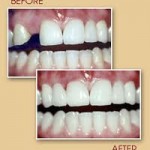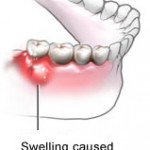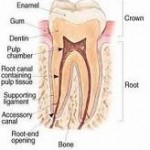A normal individual has a complete set of thirty two teeth, sixteen on the upper jaw and sixteen on the lower jaw. We have three molars on each side of the jaw. The third molar, also known as the wisdom tooth, is the last tooth to erupt. The wisdom tooth erupts at the age of 18 to 24. There are instances when this tooth does not erupt due to obstruction in the path of eruption caused by several factors. The condition where tooth with fully formed roots fail to erupt due to an obstruction (normal or pathological) is known as impaction. Even the canines and the premolars can be impacted. There are several causes of tooth impaction:
1. Evolution- The food that we eat now is more refined, softer and starchy compared to the harder,coarser food early humans used to eat. As a result, our jaw has evolved over time, being smaller and less defined. Yet, the number of teeth has remained and all the 32 teeth have to fit into the space provided by the jaw. Therefore, the wisdom tooth which is the last to erupt has less space and remains buried beneath the soft tissues and bone.
2. Genetic factors- Certain genetic conditions such as amelogenesis imperfecta and cleidocranial dysplasia cause disturbance in the formation of tooth substance making it fail to erupt.
3. Endocrine disorders- Endocrine disorders such as hypopituitarism, hypothyroidism and hypoparathyroidsm interferes with the secretion of hormones that is involved with the growth, development and eruption of tooth. Lack of these hormones results in missing teeth, delayed or even failed eruption of teeth.
4. Extraction of primary molars- The permanent molars start erupting at the age of six to seven. Children sometimes have severely decayed deciduous molars requiring extraction before the permanent tooth erupts. This creates space into which the adjacent tooth erupts. As a result, the underlying permanent tooth has no space to erupt when it reaches the eruption time and remains unerupted. This condition may lead to malalignment of teeth requiring further extraction and orthodontic treatment in severe situation. To prevent this a space maintainer which is designed by the dentist is placed at the extraction socket of the deciduous molar and it remains there until the underlying permanent molar erupts.
5. Lack of eruption space- Some people have small sized upper and lower jaws and relatively large sized teeth. The last tooth to erupt will usually have no space to erupt, hence remain impacted.
6. Obstruction- Scar tissue, fibromatosis, cysts and tumours can also obstruct the path of eruption of tooth.
An impacted tooth need not removed unless it poses problem to the individual. A more conservative approach is practised in following situations:
1. When the tooth is asymptomatic and does not interfere with normal function of the patient
2. Absence of any pathology and infection which leads to pain, swelling and further spread of infection
3. Recent research has shown that impacted wisdom tooth does not cause movement of teeth in the anterior region and therefore cause crowding of anterior teeth (this condition is known as imbrication). Therefore, removal of wisdom tooth to prevent crowding is not justified
4. A more conservative approach is preferred in patients who are medically compromised. Surgical removal of and impacted tooth may cause more risks to such patients compared to its benefit.
5. Patients with bone cancer at the jaw region are not advised to undergo surgical removal of impacted tooth. This is because future radiation to the region where the surgery has been done can cause osteoradionecrosis causing more damage to the jaw and complications.
There are situations where surgical removal of an impacted tooth is advised:
1. Impacted tooth can lead to infection such as pericoronitis and abscess formation. The position of tooth can lead to food accumulation beneath the soft tissues and there areas are difficult to access with toothbrush. This will lead to infection, swelling and pus formation. Pericoronitis is the infalammation of the soft tissues surrounding the impacted tooth. If left untreated the infection can cause formation of abscess and lead to cellulitis( inflammation of the connective tissue) in severe conditions.
2. Grossly decayed impacted tooth should also be removed because it can cause periapical abscess formation.
3. Tooth in line of fracture.
4. Tooth involved with cyst and tumour.
5. For prosthodontic reasons where there is need for a complete denture of if patients requires implant for aesthetic purpose.
6. For orthodontic reason, where space is needed distally for the movement of teeth brought about by orthodontic appliance.
7. In cases where impacted tooth causes impingement of soft tissues, chronic pain and discomfort.




